-
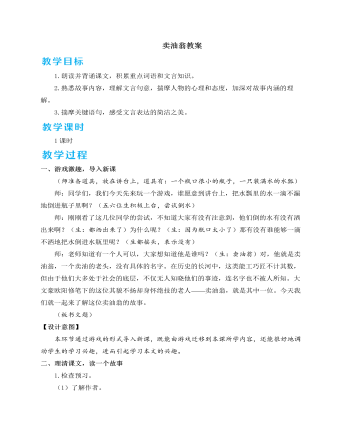
人教部编版七年级下册卖油翁教案
本篇故事虽短,但记述简洁生动,情趣盎然,人物形象鲜明,哲理深入浅出,是学生了解传统文化,学习浅易文言文,增强文言语感的经典文言小品文。所以本教学设计首先注重落实字词基础;然后用抢答的方式帮助学生理解课文内容;再以人物为核心,细读课文,通过表演的方式,抓住重点实词、虚词,揣摩人物的心理和个性特点,了解文言语言简洁精练的特点,激发学生学习文言文的兴趣。通过质疑探究,走进文本背后,引导学生学习探究文言故事的方法,培养学生独立思考、质疑探究的能力。文学知识笔记体小说笔记体小说指具有小说性质,介于随笔和小说之间的一种文体,是中国古典小说的一种。笔记体小说多以人物趣闻逸事、民间故事传说为题材,具有写人粗疏、叙事简约、篇幅短小,形式灵活、不拘一格的特点。笔记体小说的起源可以追溯到南朝刘义庆的《世说新语》。代表作有清代纪昀的《阅微草堂笔记》等。
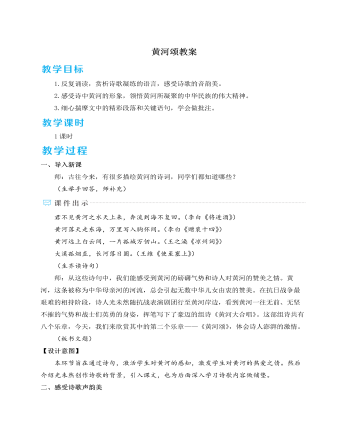
人教部编版七年级下册黄河颂教案
资料链接1.《黄河大合唱》《黄河大合唱》是由光未然作词、冼星海谱曲的一部大型合唱音乐作品,有《黄河船夫曲》《黄河颂》《黄河之水天上来》《黄水谣》《河边对口曲》《黄河怨》《保卫黄河》《怒吼吧,黄河!》八个乐章。诗中将雄奇的想象与现实的图景结合在一起,组成了一幅幅壮阔的历史画卷。2.中华民族精神中华民族在悠久的发展历史中,积淀和形成了自己独特而伟大的民族性格和民族精神。中华文化的基本精神,表现了自强不息、居安思危、厚德载物、乐天知足、崇尚礼仪等特征。中华文化的力量,集中体现为民族精神的力量。中华民族精神的核心是爱国主义。这种精神就像是泰山、长城一般壮丽地雄峙于世界的东方!疑难探究如何把握《黄河颂》语言上的特点?这首歌词写得明快雄健,节奏鲜明,音节洪亮。以短句为主,兼以长句;长短结合,自由奔放并且错落整齐。在韵脚上,隔二三句押韵,形成了自然和谐的韵律。

人教部编版七年级下册老山界教案
【设计意图】本环节既总结了学习的内容,也拓展了文章的主题;引导学生理解长征精神在当今时代的作用、意义,并传承长征精神,接受革命传统教育。四、总结存储1.教师总结。文章在叙述红军翻越老山界的经过中,进行了富有抒情气息的描写,展现了红军伟大的精神力量,也让我们感受到了长征岁月中浪漫的英雄情怀。岁月沧桑,斗转星移,中国已发生翻天覆地的变化,长征精神亦成为中华民族的宝贵精神财富。年轻一代的我们,应坚定信念,弘扬长征精神,为中华民族的伟大复兴而努力,弹奏新征途的“天籁之音”。2.布置作业。(1)课外选读:《大渡河畔英雄多》(杨得志)、《越过夹金山,意外会亲人》(杨成武)。(2)以小组为单位编写一期有关长征精神的手抄报,参加班级展示活动。
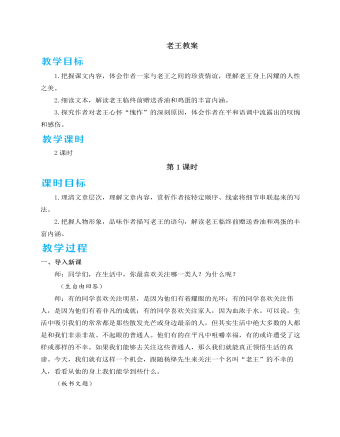
人教部编版七年级下册老王教案
素养提升作文中怎样运用“以小见大”的写作手法(1)以小人物见大。这里的“小人物”是指在社会上不出名、没有影响的人。以小人物见大,即以生活中平凡的小人物为叙写对象,通过塑造小人物的形象,揭示其闪光的品质,彰显其伟大的人格,折射出底层人民的光芒,喻人以大道理,动人以大感情,从而起到激励、感化读者的大作用。(2)以小事见大。可以通过叙写生活中极其平常的小事阐述一个大的道理。文化常识典故故事——君子之交“君子之交”语出《庄子·山木》:“且君子之交淡若水,小人之交甘若醴;君子淡以亲,小人甘以绝。”君子之交,意思是贤者之间的交情,平淡如水,不尚虚华。唐贞观年间,薛仁贵尚未得志之前,与妻子住在一个破窑洞中,衣食无着落,全靠王茂生夫妇接济。后来,薛仁贵参军,在跟随唐太宗李世民御驾东征时,立下汗马功劳,被封为“平阳郡公”。一登龙门,身价百倍,前来送礼祝贺的文武大臣络绎不绝,可都被薛仁贵婉言谢绝了。
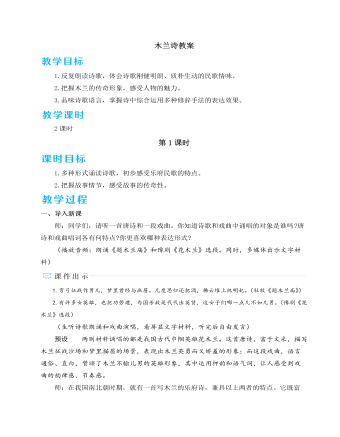
人教部编版七年级下册木兰诗教案
本教学设计着眼于民歌特点。第1课时重在诵读诗歌,设计不同层次的读,引导学生从诗歌的形式、节奏、韵律、情感四个方面感受民歌形式自由、具有韵律美、节奏感强、情感富于变化的特点,从而体会民歌的情味。第2课时重在品读诗歌,引导学生通过品析情节、品味语言、析读主题等方式,体会诗歌语言刚健明朗而质朴生动的特点,逐层解读民歌所塑造的传奇形象,并理解民歌所传达的爱国情怀。素养提升互 文互文,也叫互辞,是古诗文中常用的一种修辞手法。古文中对它的解释是:“参互成文,合而见义。”具体地说,它是这样一种表现形式:上下两句或一句话中的两个部分,看似各说两件事,实则是互相呼应,互相阐发,互相补充,说的是一件事。即上下文义互相交错、互相渗透、互相补充地来表达一个完整的意思。初中阶段,常见的互文一般有三类:(1)单句互文单句互文,即在同一个句子中前后两个词语在意义上相互交错、渗透、补充。如:秦时明月汉时关。

《念奴娇 赤壁怀古》说课稿(一) 统编版高中语文必修上册
一、说教材:(一)教材的地位和作用《念奴娇﹒赤壁怀古》是部编版高中语文教材必修上册第9课的课文。它与辛弃疾的《永遇乐﹒京口北固亭怀古》,李清照的《声声慢》共同入选该册教材第三单元阅读古诗词,感悟人生这一学习专题。本词是苏轼的代表作,也是豪放词的名篇,在古诗词教学中占有重要的地位。优美的诗词是中华传统文化的瑰宝,学习这些诗词的目的在于培养学生鉴赏古代诗词作品的能力,在分析、鉴赏中感悟前人丰饶的情思,博大的智慧,从而提高学生的人文素养,提高文化品味。这首词写于元丰五年,是苏轼被贬黄州游赤鼻矶所作。本词感情激荡,意境雄浑壮阔。全词融写景、咏史、抒情为一体。通过学习,学生可以获得一些鉴赏诗词的基本要领,领略壮阔意境,感受豪放词风;同时学习苏轼在逆境中依然乐观旷达的人生观。
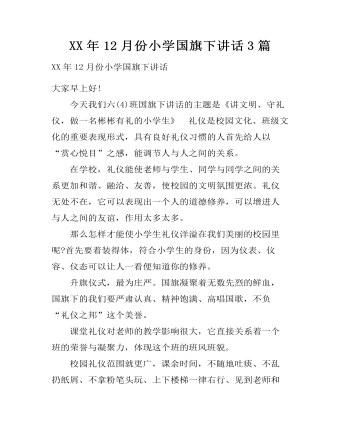
XX年12月份小学国旗下讲话3篇
XX年12月份小学国旗下讲话 大家早上好!今天我们六(4)班国旗下讲话的主题是《讲文明、守礼仪,做一名彬彬有礼的小学生》 礼仪是校园文化、班级文化的重要表现形式,具有良好礼仪习惯的人首先给人以“赏心悦目”之感,能调节人与人之间的关系。在学校,礼仪能使老师与学生、同学与同学之间的关系更加和谐、融洽、友善,使校园的文明氛围更浓。礼仪无处不在,它可以表现出一个人的道德修养,可以增进人与人之间的友谊,作用太多太多。那么怎样才能使小学生礼仪洋溢在我们美丽的校园里呢?首先要着装得体,符合小学生的身份,因为仪表、仪容、仪态可以让人一看便知道你的修养。升旗仪式,最为庄严。国旗凝聚着无数先烈的鲜血,国旗下的我们要严肃认真、精神饱满、高唱国歌,不负“礼仪之邦”这个美誉。课堂礼仪对老师的教学影响很大,它直接关系着一个班的荣誉与凝聚力,体现这个班的班风班貌。校园礼仪范围就更广,课余时间,不随地吐痰、不乱扔纸屑、不拿粉笔头玩、上下楼梯一律右行、见到老师和客人用普通话主动问好。我们还应该爱护花草树木和一切设施,爱护清洁卫生,服从老师管理和接受同学的批评劝阻。受到老师和同学的帮助,诚恳地说声谢谢。
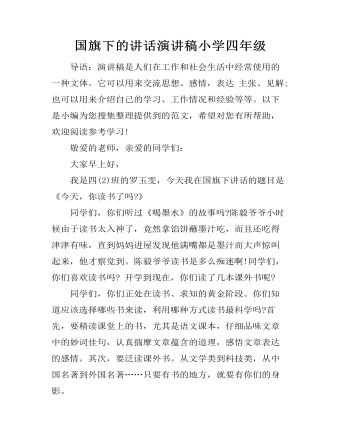
国旗下的讲话演讲稿小学四年级
导语:演讲稿是人们在工作和社会生活中经常使用的一种文体。它可以用来交流思想、感情,表达 主张、见解;也可以用来介绍自己的学习、工作情况和经验等等。以下是小编为您搜集整理提供到的范文,希望对您有所帮助,欢迎阅读参考学习!敬爱的老师,亲爱的同学们:大家早上好,我是四(2)班的罗玉雯,今天我在国旗下讲话的题目是《今天,你读书了吗?》同学们,你们听过《喝墨水》的故事吗?陈毅爷爷小时候由于读书太入神了,竟然拿馅饼蘸墨汁吃,而且还吃得津津有味,直到妈妈进屋发现他满嘴都是墨汁而大声惊叫起来,他才察觉到。陈毅爷爷读书是多么痴迷啊!同学们,你们喜欢读书吗? 开学到现在,你们读了几本课外书呢?同学们,你们正处在读书、求知的黄金阶段。你们知道应该选择哪些书来读,利用哪种方式读书最科学吗?首先,要精读课堂上的书,尤其是语文课本,仔细品味文章中的妙词佳句,认真揣摩文章蕴含的道理,感悟文章表达的感情。其次,要泛读课外书。从文学类到科技类,从中国名著到外国名著……只要有书的地方,就要有你们的身影。读书,需要时间。时间在哪里?它就在我们每一个人的双手里。你一松手,它就从指间溜走了因此,读书需要只争朝夕。一早到校,可以读书;午间休息,可以读书;睡觉之前,可以读书。

人教版新目标初中英语七年级下册How was your weekend教案2篇
Teaching Goal:1. General aims:Talk about recent past events2. Particular aims:A. Language Focus.Talk about recent past events and think of the past events.B. Language goalsHow was….?It was …What did …do over the weekend?C. Language structures:(1). How was your weekend? I was great. Pay attention to no form.(2). What did you do over the weekend? I played soccer. We went to the beach.D. Useful words and phrases:Words: was, did, went, beach, over, project, test, wasn’t, false, number, geography, spend, week, most, mixture, their, had, little, cook, read, saw, change, everyone, sit, sat, no, anythingPhrases: did one’s homework, played soccer, cleaned my room, went to the beach, played tennis, went to the movies, on Saturday morning, over the weekend, cook … for, what about, do some reading, have a party, talk show, go shoppingE. Grammar language:Present simple past tenseRegular and irregular verbsF. Learning strategies:Tour and holidaysG. Interdiscipinary:H. Emotion and manner:Teaching time: 5 periodsTeaching procedures:Period One教学步骤、时间 教师活动 学生活动 媒体应用Step 1Free talk 3’ Ask some questions like:Who’s on duty today?What’s the weather like? Answer and talk about something.让同学们回答下列问题1. Do you like weekend? (Let some students answer)It takes them three minutes to talk about the question.2. Why do you like weekend? (let the students answer) Most of the students like the weekend此时教师用汉语问:“在周末期间问你干了什么?这句话用英语这么回答?Let the students guess.At last the teacher give them right answer3. What did you do over the weekend?(板书、学习)

人教版新目标初中英语七年级下册Where is the post office教案2篇
Period 2 (3a----Section B 2c)Preview(Pre-task): Key points: What laAdd another information about their pen pals----their language on the cardnguage does she/he speak?She/He speaks....Does she/he have any brothers and sisters? Does she/he speak English?Preview(Pre-task): Add another information about their pen pals----their language on the cardKey points: What language does she/he speak?She/He speaks....Does she/he have any brothers and sisters? Does she/he speak English?Step 1 Revision1.Revisionand dictation of the new words 2.Revise the drills they learned yesterday.(by pairwork and grammar exercise)Step 2 Leading-inT has a conversation with one student. The conversation is following:---Do you have a pen pal?---Yes, I do.---What's your pen pal's name? ---His/Her name is....---Where is your pen pal from? ---He/She is from...---Where does he/she live? ---He/She lives in....---What language does he/she speak?He/She speaks...Write the new words on the Bb. They are following: EnglishChineseJapaneseFrenchStep 3 LearnLearn the new words with the whole class.Finish 3a with the students3b Pairwork T still does an example with one student Then the Ss practise in pairs. The example is following:--Curry Muray is my pen pal. He is from the United States.---What language does he speak?

人教版新目标初中英语七年级下册Don’t eat in class教案2篇
Don’t fight. =You can’t fight. (板书,教读)教师把这些句子板书在黑板上,并请学生大声整齐地读祈使句和“can’t”句型,并让学生注意两种句型表达形式的不同和转换,“Don’t …=You can’t…”;并对学生说:These are our school rules. (板书,教读) You can’t break the school rules. Don’t break the school rules.(板书,教读)步骤3 :Practicea. T: Now, each of the students is breaking one of these rules.Please finish 1a.学生看图,完成1a的内容,检查答案并大声朗读校规。b. 听录音,完成1b,选出四位学生都违反了哪条校规;听之前,学生要读会英文名。c. 请两位学生朗读1c部分的句型;要求学生两人一组对话表演,SA扮演外校转来新生,SB告知本校校规。(学生可经过讨论,多说出他们想到的校规,不必只限于书上;教师应给予帮助)2) 第二课时(2a~4)步骤1 :warming up of revisionT: What are the rules at your school?学生使用“can”或祈使句表达各条校规;其中老师可引出“eat in the cafeteria outside”的表达。步骤2 :Practicea.T: Christina is an exchange student. She doesn’t know the rules. Let’s listen, what activities they’re talking about?学生听第一遍时,完成2a;第二遍时,完成2b;b. 请学生领读2c部分,看着2a完成的表格,理解2c活动的要求;分成小组针对2a进行问答;

人教版新目标初中英语七年级下册I want to be an actor教案2篇
三、教学建议第一课时:1. Lead in (Vocabulary)A) Before class, teacher should collect some pictures of working places. For example: Bank, TV Station, Restaurant, Police Station, Hospital ...B) In class, show students the pictures (PowerPoint, OHP). Ask students to tell the name of the working places and the name of the jobs.Shop assistant, doctor, actor, reporter, police office, waiter, bank clerk, studentC) Do exercise 1a and 3a.2. Bingo GameAsk groups of students to make up pairs of cards with a job on one and the related workplace on the other. For example, waiter / restaurant, teacher / school, doctor / hospital. Encourage students to use both the job / workplace combinations in the book and the ones that students came up during class discussions. Be sure they have twice as many sets of cards as there are students in the group. They can make two sets of cards for a single job / workplace, if necessary. Then have each group mix up its set of cards and hand their cards out in random order. Each time a student gets a pair of cards that match, he or she can lay these cards down. The goal is to have no cards in your hand at the end.3. Task OneA) Ask students to work in pairs and ask the partner what does he / she want to be in the future.e. g. :What do you / does he / does she want to be?I want to be a.Why?Because it's (adj).B) Vocabulary: Section B, 1a4. Homework 1.2.

人教版新目标初中英语七年级下册Why do you like koalas教案2篇
单元整体说明(一)单元教材分析本单元的核心话题是描述动物和表达个人喜好,以及句式why do you like…? Because…。这也是本单元的教学重点。通过本单元的学习,学生应能较流利地运用所学词汇和句型描述动物,表达个人喜好。(二)单元知识结构1.词汇动物名称 tiger, elephant, koala, dolphin, etc.词汇描述性形容词: smart, cute, ugly, clever, shy, etc.国家名: Australia, South Africa2.句型Why do you like koala hears? Because they are cute.Where are pandas from? They're from China.What animals do you like? I like dolphins.(三)单元整体目标1.Master the vocabulary2.Master and use: Why do you like koalas? Because they am cute.Where are pandas from? They're from China.What animals do you like? I like dolphins.(四)单元教学重难点一览(五)单元学情分析学生此前已经学过由why, where, what 引导的特殊疑问句句型,具有了学习本单元知识的认知前提。形形色色的动物能激发学生的好奇心,产生了解它们的欲望,这有利于本单元知识的教学和学生学习兴趣的培养。

人教版新目标初中英语八年级下册What should I do教案2篇
说明:在帮Li Lei提建议的同时,教育学生如何学好英语。第三课时教学目标1. 语言目标:a) 词汇: Original, in style, haircut, the same as.b) 语言结构:My friend wears the same clothes and has the same haircut as I do.2. 能力目标:大多数学生能够谈论自己喜欢哪种服装,提高查找信息的能力。3. 情感目标:学会如何与朋友相处,要有自己对时尚的看法。教学重点掌握一些重要词汇。教学难点学会谈论问题,并能提出书面建议。◆教学突破首先针对Erin的问题,提出个人的建议,模仿2c部分的对话展开双人交际Pair-work;听老师诵读3a部分的信件,并找出LEFT OUT的问题所在;学生完成3b部分的内容,给Left Out提出书面的建议;学以口头形式提出自己目前存在的某个问题,讲给大家听,让同学们给自己提出一个建议,并作笔录;学生两、三个人分成一组,随意性地进行口语交际,谈论P14的第4部分的某个问题,相互交换意见。

人教版新目标初中英语八年级下册If you go to the party, you’ll have a great time教案2篇
区分宾语从句、定于从句和状语从句宾语从句和状语从句,都叫做主从复合句。宾语从句主要是中考必考的,是初中阶段必掌握的从句,宾语从句主要是掌握三要素,所谓宾语从句,就是宾语在主从复合句当中充当宾语的一个句子,叫做宾语从句。主句的谓语动词是及物动词,后面如果是词或者是短语的话,是简单句,如果是句子的话,肯定是宾语从句。I know that he good at English.就是宾语从句,三要素,一要素是要注意连词,连词一共学了三类连词,一类连词是that口语当中可以省略,就像刚才说的那一句,I hear he is good at English.还有疑问代词、疑问副词,how where when,疑问代词、疑问副词。还有一类连词weather是否的意思,不是状语从句当中的如果,这一定要和如果区分开,这是是否。I don't know if he interested at English。宾语从句要注意if是连词。第二要素是语序,要用陈述举语序。比如说你家有几口人,我们都说How many people are there in you family?但是这是简单句,一旦说成宾语从句,你可以告诉我你家有几口人吗?Could you tell me how many people there are in you family ?

人教版新目标初中英语八年级下册He said I was hard-working教案2篇
This activity introduces some new vocabulary and provide oral practice using the target language.Task 1 . Ask four students to stand in front of the class, and the teacher asks them the following questions as a reporter.1.What are you going to do when you grow up?2.What are you going to do next week?3.What are going to do after school?The students will give different answers, then ask a good student to report what they said.I am going to e a doctor.What did she say?----------She said she was going to be a doctor.I am going to have a party on Friday night.What did he say?-------He said he was going to have a party on Friday night.I am going to do my homework.What did she say ?------ She said she was going to do her homework.I am going home after school.What did she say?-----She said she was going home after school.Say In this unit we are going to learn to use words like to report what someone said.Task 2. Read the instructions. Then ask a student to read the four questions. And write the words on the Bb. Explain what soap opera is.Task 3. Ask the students to Look at the pictures, point out the TV screens in the picture. Ask one girl to read what Marcia said.What did Marcia say? She said She said she was having a surprise party for Lana on Friday night. Repeat the other pictures in the same way.Activity3. Listen and number the pictures in activity 1a.

人教版新目标初中英语八年级下册How long have you been collecting shells教案2篇
Step Ⅱ Show the new words on the screen and teach the new words. Read the new words to students and ask them to repeat.Step Ⅲ 3aThis activity introduces new vocabulary and provides reading practice using the target language.In this activity first look at the four pictures.T: What can you see in the pictures?Ss: Four snow globes.T: Right. There are four snow globes in the pictures. And what are they?Ss: They are a monster, two polar bears, two penguins and a birthday cake.Write these words on the blackboard: snow globe; monster; polar bear; penguin and birthday cake. Read them to the class and ask students to repeat each one. Make sure students understand each word.Use a computer to show the E-mail message on the screen and read the message to students.Get students to read the e-mail on their own, and then draw lines connecting each snow globe and its description.Correct the answers.AnswersA line should connect each snow globe picture with the words that describe it in the letter.Step Ⅳ 3bThis activity provides writing practice using the target language.First review Activity 2a on Page 47.Then ask students to complete the message according to Activity 2a.Some partial sentences are given to students. Write about one person's collection.When students work, walk around the room checking the progress and offering help as needed.When they finish, ask some students to read their messages to the class.

人教版新目标初中英语八年级下册What were you doing when the UFO arrived教案2篇
(一).知识方面: 1.培养学生能运用过去进行时来描述、谈论过去某个时间正在发生的事情或动作的意识和能力,能就过去某个时间正在发生的动作做出正确的描述。 2.培养学生的想象力和角色扮演的合作能力。 3.培养学生讲述过去发生的事情经过的能力。能正确运用一般过去时来讲述故事。 (二).技能方面: 1.本单元的语言目标是Talk about past events and tell a story(谈论过去的时间和讲述一个故事),围绕这一目标,要涉及句型: What were you doing when the UFO arrived? ----I was sitting in the barber’s chair. The barber was cutting my hair. 因此必须学习standing、studying、cleaning、sleeping、cooking、making、eating、cutting、等表示地点的词,以便为上述句型提供语言材料。2.学习过去进行时的有关知识。Was/were+现在分词,是该时态的表达式。 3.在学习过程中,要区分The boy was walking down the street when the UFO landed.和While the boy was walking down the street, the UFO landed.这两种由when和while引导的状语从句的句型结构。注意它们的不同。

人教版新目标初中英语七年级下册It’s raining教案2篇
1 Each group choose one place to describe and what you are doing in it Choose one place, and describe what they are doing 2 Move around the room and give suggestions Talk about it and write it down 3 Ask one to show their works and act it Choose one of each group to make a report 4 Evaluate the best group and the best reporter Choose the best one Homework Ask your friends their ideal place and write about it教学反思:新课程标准中强调学生在课堂中的主体地位,在综合课中他们的主体地位就更加突出。在各个活动中给不同程度的学生不同层次的任务,让各层面的学生都有表现发挥的机会,从而产生对英语的兴趣。使用照片图片多媒体来辅助教学,效果更好。同时让了解其他国家风景,风俗的同学介绍ideal place,增加学生的背景知知识,实现跨学科交流的目的。教案点评:采用任务型教学模式,在各个活动中给不同程度的学生不同层次的任务,让各层面的学生都有表现发挥的机会,从而产生对英语的兴趣。使用照片图片多媒体来辅助教学,效果更好。让了解其他国家风景,风俗的同学介绍ideal place,增加学生的背景知识,实现跨学科交流的目的。

人教版新目标初中英语八年级下册It’s a nice day, isn’t it教案2篇
"Hello! Welcome to English class! Introduce yourself. Meet your new classmates." That's what the teacher says. What do you say? "Oh no!" It can be difficult talking to new people. But it can be fun, and you can make friends. How do you do it? Make small talk. Small talk is polite conversation. "Wang Nan is a great pingpang player, isn't she?" "I'd love to meet her, wouldn't you?" "It's been raining a lot, hasn't it?" Tag questions are a form of polite speech. To make small talk successfully, you should know how to make them. You should also know what topics to talk about. Try to learn this unit carefully. The next time you're in English class, you'll find out. Making small talk's easy, isn't it? (“你好!欢迎你!请做一下自我介绍。认识一下你的新同学。”通常在课上老师会这样说。你会说什么呢?“噢,不!”与陌生人谈话太困难了。但是这也很有意思,并且你还能交到朋友。你该怎么做呢?闲聊。闲聊指得是礼貌的对话。“王楠是一个很棒的乒乓球运动员,不是吗?”“我希望自己能认识她,你呢?“今年的雨水很多,不是吗?”反意疑问句是一种礼貌用语。为了使得谈话成功,你应该知道怎样去进行闲聊。你还应该知道与不同的人该谈论什么样的话题。认真的学习这个单元吧,下次在英语课上,你会发现与大家展开谈话是一件很容易的事情,不信我们来试试。)






